Page 825 - Krugmans Economics for AP Text Book_Neat
P. 825
You might think that the fact that sellers of used cars know more about them than
Adverse selection occurs when one
buyers do represents an advantage to the sellers. But potential buyers know that poten-
person knows more about the way things
tial sellers are likely to offer them lemons—they just don’t know exactly which car is a are than other people do. Adverse
lemon. Because potential buyers of a used car know that potential sellers are more selection exists, for example, when Section 14 Appendix
likely to sell lemons than good cars, buyers will offer a lower price than they would if sellers offer items of particularly low
they had a guarantee of the car’s quality. Worse yet, this poor opinion of used cars (hidden) quality for sale, and when
tends to be self-reinforcing, precisely because it depresses the prices that buyers offer. the people with the greatest need for
Used cars sell at a discount because buyers expect a disproportionate share of those insurance are those most likely to
cars to be lemons. Even a used car that is not a lemon would sell only at a large dis- purchase it.
count because buyers don’t know whether it’s a lemon or not. But potential sellers who Adverse selection can be reduced
have good cars are unwilling to sell them at a deep discount, except under exceptional through screening: using observable
circumstances. So good used cars are rarely offered for sale, and used cars that are of- information about people to make
fered for sale have a strong tendency to be lemons. (This is why people who have a com- inferences about their private information.
pelling reason to sell a car, such as moving overseas, make a point of revealing that
information to potential buyers—as if to say “This car is not a lemon!”)
The end result, then, is not only that used cars sell for low prices but also that there
are a large number of used cars with hidden problems. Equally important, many poten-
tially beneficial transactions—sales of good cars by people who would like to get rid of
them to people who would like to buy them—end up being frustrated by the inability of
potential sellers to convince potential buyers that their cars are actually worth the
higher price demanded. So some mutually beneficial trades between those who want to
sell used cars and those who want to buy them go unexploited.
Although economists sometimes refer to situations like this as the “lemons prob-
lem” (the issue was introduced in a famous 1970 paper by economist and Nobel laure-
ate George Akerlof entitled “The Market for Lemons”), the more formal name of the
problem is adverse selection. The reason for the name is obvious: because the poten-
tial sellers know more about the quality of what they are selling than the potential buy-
ers, they have an incentive to select the worst things to sell.
Adverse selection does not apply only to used cars. It is a problem for many parts of
the economy—notably for insurance companies, and most notably for health insurance
companies. Suppose that a health insurance company were to offer a standard policy
to everyone with the same premium. The premium would reflect the average risk of in-
curring a medical expense. But that would make the policy look very expensive to
healthy people, who know that they are less likely than the average person to incur
medical expenses. So healthy people would be less likely than less healthy people to buy
the policy, leaving the health insurance company with exactly the customers it doesn’t
want: people with a higher-than-average risk of needing medical care, who would find
the premium to be a good deal. In order to cover its expected losses from this sicker
customer pool, the health insurance company is compelled to raise premiums, driving
away more of the remaining healthier customers, and so on. Because the insurance
company can’t determine who is healthy and who is not, it must charge everyone the
same premium, thereby discouraging healthy people from purchasing policies and en-
couraging unhealthy people to buy policies.
Adverse selection can lead to a phenomenon called an adverse selection death spiral as
the market for health insurance collapses: insurance companies refuse to offer policies
because there is no premium at which the company can cover its losses. Because of the
severe adverse selection problems, governments in many advanced countries assume
the role of providing health insurance to their citizens. The U.S. government, through
its various health insurance programs including Medicare, Medicaid, and the Chil-
dren’s Health Insurance Program, now disburses more than half the total payments for
medical care in the United States.
In general, people or firms faced with the problem of adverse selection follow one of
several well-established strategies for dealing with it. One strategy is screening: using
observable information to make inferences about private information. If you apply to
purchase health insurance, you’ll find that the insurance company will demand docu-
mentation of your health status in an attempt to “screen out” sicker applicants, whom
module 79 Appendix 783

